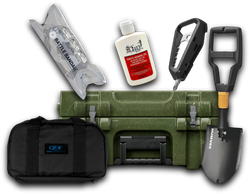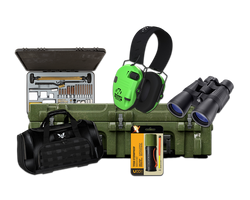What Does the M Stand for in M16 Rifle?
Table of Contents
- Introduction
- The Historical Context of the M16
- Understanding Military Nomenclature: What Does the "M" Stand For?
- Evolution of the M16: From M16 to M16A4
- Operational Capabilities of the M16
- Key Features and Components
- Current Status and Legacy
- Conclusion
- FAQ
The M16 rifle has become an iconic symbol of the U.S. military and modern warfare. Its sleek design, lightweight construction, and versatility in various combat situations have made it a staple for troops since its inception. But amidst its storied history and technical advancements, a simple question persists: what does the "M" stand for in "M16"?
Understanding the nomenclature of military firearms is crucial for anyone interested in tactical gear, firearms history, or military science. As we delve into the details behind the M16, we will explore not just the meaning of the "M," but also the rifle's evolution, its operational significance, and the context in which it has been used. By the end of this post, readers will gain a comprehensive understanding of the M16 and its impact on military operations worldwide.
Introduction
The M16 rifle, officially designated as the "Rifle, Caliber 5.56 mm, M16," is part of a long line of military firearms that have been designated with the "M" prefix. This designation has led to some confusion among enthusiasts and newcomers alike regarding its meaning. Many assume it stands for "military," but as we will discuss, the truth is more nuanced.
The significance of the M16 extends well beyond its name. It is a product of rigorous testing, design innovation, and adaptability to the needs of modern warfare. From its debut in the Vietnam War to its current use across various branches of the U.S. military and allied forces, the M16 has undergone numerous upgrades and modifications, making it one of the most recognized firearms globally.
In this blog post, we will cover:
- The historical context surrounding the M16's development.
- A detailed explanation of military nomenclature and the meaning behind "M."
- The evolution of the M16 through its various models and upgrades.
- Its operational capabilities, including performance and specifications.
- Key features and components that set the M16 apart from other firearms.
- The current status of the M16 in military service and its legacy.
By examining these aspects, readers will come away with a well-rounded understanding of the M16 rifle and its place in military history.
The Historical Context of the M16
To appreciate the M16 fully, one must understand its roots in the evolving landscape of military firearms. The U.S. military's journey towards adopting a lightweight, high-velocity rifle began in the aftermath of World War II. As combat experiences highlighted the limitations of existing firearms like the M1 Garand and M14, the need for a more effective infantry weapon became apparent.
Development of the ArmaLite AR-15
The M16 originated from the ArmaLite AR-15, designed by Eugene Stoner in the late 1950s. The AR-15 was revolutionary for its time, featuring a lightweight aluminum construction and a smaller caliber, 5.56 mm cartridge, which provided soldiers with a higher rate of fire and greater ammunition capacity. In 1956, the U.S. military began to explore the potential of the AR-15, recognizing that a smaller caliber could provide effective firepower while reducing the weight burden on soldiers.
Adoption by the U.S. Military
The transition from the AR-15 to the M16 was not immediate. The U.S. military conducted extensive testing and evaluations before officially adopting the rifle. In 1964, the M16 rifle entered service, and soon after, it was deployed in the Vietnam War. However, early models faced significant reliability issues, primarily due to inadequate maintenance training and improper ammunition. These shortcomings led to a tarnished reputation that the rifle would take years to overcome.
By the late 1960s, improvements had been made, resulting in the M16A1, which included a chrome-lined barrel and other enhancements to increase reliability. The M16A1 eventually became the U.S. military's standard service rifle, supplanting the M14 and establishing the M16 as a key player in modern warfare.
Understanding Military Nomenclature: What Does the "M" Stand For?
The "M" in M16 is part of a structured nomenclature system used by the U.S. military to designate weapons and equipment. Understanding this system sheds light on what the "M" represents and how it fits into the broader context of military designations.
The "M" Designation
The "M" designation is shorthand for "Model." In military nomenclature, this prefix indicates that the item is a standard model of a weapon or equipment. For instance, the M1 Garand, M14, and M16 all follow this naming convention. The number following the "M" does not signify a chronological order but rather represents the specific model within the military's naming system.
Evolution of Military Designations
-
XM Designation: Before officially adopting a new weapon, the military often designates it with an "XM" prefix, indicating that it is an experimental model. For example, the XM16E1 was an experimental model of the M16 before it became the standard M16A1.
-
A Suffix: The letter "A" followed by a number (e.g., M16A1, M16A2) signifies modifications or alterations made to the original model. The M16A1 introduced improvements based on battlefield feedback and testing, while the M16A2 included further design enhancements.
-
Numerical Order: Each new model is assigned a sequential number. The absence of an M15 designation is notable, as this model was never developed due to the small modifications made to the M14 that weren’t significant enough to warrant a new model designation.
Clarification on Misconceptions
While many believe that the "M" stands for "military," it is essential to clarify that the designation strictly means "Model." The military uses this system for all types of equipment, including vehicles, weapons, and ordnance. Thus, the M16 is simply "Rifle, Caliber 5.56 mm, Model 16."
Evolution of the M16: From M16 to M16A4
Over the decades, the M16 has undergone various upgrades and iterations, resulting in improved performance and reliability. Let’s explore the evolution of the M16 rifle through its major variants.
M16 (Original Model)
-
Introduction: The original M16 was introduced into service in 1964. Its lightweight design and high rate of fire made it an appealing choice for soldiers in Vietnam. However, it faced reliability challenges, especially in harsh environmental conditions.
-
Specifications: The first models had a 20-round magazine and fired the 5.56×45 mm NATO cartridge.
M16A1
-
Adoption: The M16A1, standardized in 1969, included several modifications based on combat experiences from Vietnam. Key upgrades included a chrome-lined barrel to reduce corrosion and improve extraction reliability.
-
Features: The M16A1 also implemented a forward-assist feature, allowing soldiers to manually ensure the bolt was locked in place, addressing some of the jamming issues experienced with the original model.
M16A2
-
Introduction: Adopted in the 1980s, the M16A2 made substantial changes aimed at improving accuracy and versatility. The most significant change was the introduction of a new barrel with a faster twist rate to stabilize the heavier 62-grain bullets.
-
Dual-Mode Fire: The M16A2 featured a semi-automatic and three-round burst fire mode, enhancing ammunition conservation while maintaining firepower.
M16A3 and M16A4
-
M16A3: This model retained the M16A2's features but added a fully automatic firing option, primarily used by the Navy SEALs and other specialized units.
-
M16A4: The M16A4, introduced in 1997, featured a flat-top receiver with a detachable carrying handle, allowing for easier mounting of optics and accessories. It became the standard infantry rifle for the U.S. Marine Corps.
Operational Capabilities of the M16
The M16's design and features contribute to its operational effectiveness on the battlefield. Understanding its capabilities is vital for assessing its role in military engagements.
Specifications
- Caliber: 5.56 mm NATO
- Weight: Approximately 7.5 pounds (unloaded)
- Length: 38.5 inches
- Rate of Fire: 700-950 rounds per minute
- Effective Range: 550 meters for point targets, up to 800 meters for area targets
- Magazine Capacity: Typically 30 rounds, with 20-round options available.
Performance
The M16 is renowned for its accuracy, largely due to its low recoil and high velocity. The rifle's design allows for quick follow-up shots, making it effective in both semi-automatic and burst modes. Furthermore, the use of lighter ammunition enables soldiers to carry more rounds without significantly increasing their load.
Key Features and Components
The M16's design incorporates several features that enhance its usability and reliability. Understanding these components is essential for anyone looking to appreciate the intricacies of the firearm.
Lightweight Construction
The M16 is built using advanced materials, including aluminum alloys and composite plastics. This lightweight design allows soldiers to carry more ammunition and equipment into the field without being weighed down.
Gas Operation System
The M16 uses a gas-operated, rotating bolt system, allowing it to harness the gases produced by firing to cycle the action. This mechanism contributes to the rifle's reliability and capability in sustained fire situations.
Modular Design
The M16's modular construction allows for various attachments, including optics, grenade launchers, and bipods. This adaptability has made it a favorite among military personnel, who can customize their rifles based on mission requirements.
Current Status and Legacy
While the M16 has been largely replaced by the M4 carbine in frontline combat roles, it remains a vital part of military arsenals. Many countries continue to use the M16 in various capacities, and it has influenced the design of countless firearms.
Continued Use
The M16 is still in service with many armed forces worldwide, including NATO allies. Its legacy is reflected in the continued production of civilian variants, which are popular among firearm enthusiasts and collectors.
Cultural Impact
The M16 has not only shaped military operations but has also become a cultural icon. It has appeared in countless films, video games, and literature, symbolizing military prowess and modern warfare.
Conclusion
The M in M16 stands for "Model," a designation that signifies its place within the U.S. military's structured nomenclature system. However, the significance of the M16 transcends its name. This rifle has played a pivotal role in military history, evolved through numerous iterations, and has set a benchmark for modern infantry weapons.
From its inception through rigorous testing and battlefield use, the M16 has demonstrated remarkable adaptability and performance. As tactical enthusiasts, understanding the M16's history, specifications, and unique features empowers us to appreciate its contributions to military effectiveness and its enduring legacy.
For those interested in enhancing their tactical gear, consider exploring Crate Club's subscription services, which offer a curated selection of survival tools, tactical gear, and more. Join a community of preparedness enthusiasts and equip yourself with the best gear available. Check out the Crate Club Subscription Services and explore the Crate Club Shop for the latest in tactical equipment.
FAQ
What does the "M" in M16 stand for?
The "M" stands for "Model," indicating that it is a standard model weapon within the military's nomenclature system.
What are the main differences between the M16A1 and M16A2?
The M16A2 introduced several modifications, including a chrome-lined barrel, a different rifling twist rate, and a three-round burst fire mode, enhancing accuracy and reliability.
Is the M16 still in use today?
Yes, the M16 is still in use by various military forces worldwide, although it has been largely replaced by the M4 carbine in frontline roles within the U.S. military.
What is the effective range of the M16?
The effective range of the M16 is approximately 550 meters for point targets and up to 800 meters for area targets.
Can civilians own an M16?
Civilians can legally own M16-style rifles, but they must comply with federal regulations and undergo background checks. Many civilian versions are available on the market.
Share this article



